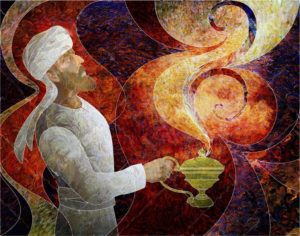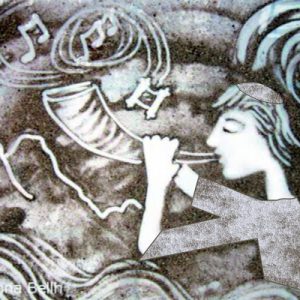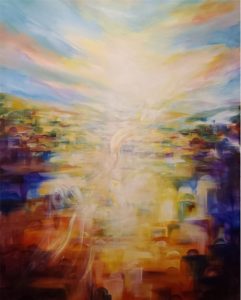
Chanukka 5784 / 2023
Sarah Yehudit Schneider
בחנוכה ובפורים מזכירין בתפלה בימי [מתתיהו…או מרדכי ואסתר], מה שלא מצינו במועדים שלא יזכירו יציאת מצרים על ידי משה ואהרן. והטעם דשם היה מפורש שהנס היה מהשם יתברך שצוה למשה ואהרן להוציא את בני ישראל ממצרים מה שאין כן כאן שעשו ישראל מעצמם. ובימי מרדכי היה על כל פנים נביאים אחרונים מה שאין כן בחנוכת חשמונאים שכבר פסקה נבואה מישראל רק הם מעצמם נתעוררו לקדש שם שמים ואף שהיה גם כן מהשם יתברך שנתן להם כח ואומץ הלב. ואחר כך עשה להם הנס לנצחם ומסר גבורים ביד חלשים ורבים ביד מעטים. מכל מקום ההתחלה היה מצדם באתערותא דלתתא והיה כעין בחינת תורה שבעל פה. ועל כן מזכירין בב’ זמנים אלו בימי וכו’, שהנס היה מצדם... ספר פרי צדיק לחנוכה – אות יד
On Chanukha and Purim we add a special holiday prayer [על הניסים] that mentions [Matisyahu or Mordecai and Esther]. This is not the case with other festivals. There we do not mention Moshe and Aharon in reference to the exodus from Egypt. The reason is that there [in Egypt], the miracle came from HaShem who had explicitly commanded Moshe and Aharon to redeem the children of Israel from Egypt. This was not the case here [in Chanukha and Purim] where the initiative came from [the people] themselves. In Mordecai’s day [during the Purim story] there were still prophets but in the Chanukha period of the Chashmona’im prophesy had ceased. It was [these named individuals], themselves who initiated the sanctification of HaShem’s name, even though HaShem was also involved and bestowed might and courage-of-heart to them. And afterwards He assured their miraculous victory where the powerful were subdued by the weak, the many by the few. Nevertheless, the initiative was from the people themselves. It all started with their ataruta d’l’tata[1] (their initiating arousal from below). This echos the pattern of Oral Torah [where the writing carries the name of its author] because their efforts and initiative are essential to the end-product—the teaching that carries the status of “oral Torah.” And so for these two holidays we mention the names [of their heroes], for the miracle was initiated by them.
On Purim and Chanukka we do not add the usual holiday prayer (yaaleh v’yavo…). Rather we add a different prayer that applies exclusively to these two (rabbinic) holidays—the prayer that begins with “al ha’nisim…” And curiously, in that prayer we actually mention the person(s) who spearheaded that chapter of history and brought us (with G-d’s help, of course) to the victory that marks these two festive days.
R. Tsadok wonders why, then, we don’t mention Moshe and Aharon in the usual holiday prayer. They seem equally crucial to our Pesach redemption as were Esther, Mordecai and Matisyahu to our Purim and Chanukka triumphs. R. Tsadok explains that HaShem explicitly commanded Moshe to go to Egypt and deliver the Hebrew people from their enslavement. The initiative came clearly from God on high (ataruta d’l’ila).
This was not the case with Purim and Chanukka. In these instances, the initiative came from the individuals mentioned, ie, from below (ataruta d’l’tata). True, on Purim there were still prophets who transmitted God’s word so, perhaps, the Purim initiative was somewhat shared. But in the Chanukka uprising, says R. Tsadok, Matisyahu was its instigator and our liturgy acknowledges that fact. In al hanisim we mention Matisyahu along with HaShem as partners in the mission. The initiator is essential to the redemption and deserves acknowledgment for their role.
Now, first, some definitions in brief. The written Torah is fixed and final. It was scribed by Moshe in a prophetic state, with every word, letter, crown and layout specified by HaShem.
The Oral Torah is commonly identified with the chain of rabbinic commentary starting with Moshe and continuing till now. But R. Tsadok broadens the definition and asserts that everyone contributes to the Oral Torah, even the most uneducated among us.[2] In this broader sense it’s the sum-total of creative insights pressed from the hearts of Jews striving to live with integrity to the truths they absorbed at Sinai.
Whereas the Written Torah derives from prophesy, the Oral Torah derives from ruach hakodesh (inspired intuition). Prophecy is generally deemed the rarer and superior channel. Its revelations are, consequently, more authoritative. Yet, in prophecy, the seer is but an instrument of Divine revelation; their dynamic is more like master and servant—the less of a mark the prophet leaves on the transmission the better. Ruach hakodesh is the opposite. Its transmission requires us to assert ourselves—to try to solve the problem independently and to give this effort our all. It is precisely this personal exertion (ataruta d’l’tata) that primes the pump which elicits the flow of guidance (and partnership) from on high.
In prophecy, the source of inspiration is obviously from HaShem, who both initiates and conducts the transmission. It is thus compared to rain which clearly originates above. Ruach hakodesh is the opposite. Like dew it appears to spring from below. Ruach hakodesh is a hybrid of creative insights emerging from the heart of its originator yet enhanced by a dose of heavenly input. Ruach HaKodesh starts with an initiating impulse from below. It needs a specific question, challenge, or goal to grab onto and, in that sense, it is different from prophecy.[3] The era of prophesy has ceased, but ruach hakodesh remains available today.
R. Tsadok, here, indicates that actions can also function as a kind of Oral Torah. In this Chanukha teaching he equates Matisyahu’s ataruta d’l’tata—his initiative to declare war on the anti-Torah Greek King—with Torah sh’b’al peh (the creative output that is the fruit of partnership between man and God). Matisyahu’s arousal from below invoked heavenly assistance which produced the partnership that distinguishes ruach hakodesh and that is the basis for deeming it superior to prophesy. The Talmud considers a sage [who is a master of oral Torah and by extension ruach hakodesh] to be superior to a prophet. (חכם עדיף מנביא).[4] And just like a sage takes credit for his book, so does a soldier take credit for a courageous initiative.
R. Tsadok proceeds to sort out who does what in this holy partnership. What is the ataruta d’l’tata that deserves recognition (like Matisyahu, Mordecai and Esther received). And what is the gift of enhancement (the ataruta d’l’ila) that gets pulled down from on high.
It seems that, in ruach hakodesh, the person who’s assuming the role of boots on the ground is the initiator and decision maker. They choose a goal, mission, problem or project and pursue it with action and prayer.[5] And if they’ve chosen good and their heart is pure, their ataruta d’l’tata draws down a wave of grace and invisible assistance (called ruach hakodesh) that, behind the scenes, gives their effort a boost and corrects its aim and maximizes its chance for success and drops thoughts into their head of how to avoid harm and improve the effort going forward. Every moment is a new initiative that draws down its new increment of grace and hidden miracles. Their alternation happens so fast it’s impossible to tease them apart. Ruach hakodesh is the ultimate partnership of man and G‑d where we initiate and G‑d responds, and both jobs are essential.
This is also a way of understanding the enmeshment of our national roles that are presently, sadly, adversarial, but are actually codependent. Let’s take this war as an example, using Matisyahu as our prototype. Among the ataruta d’l’tata-nikim are the doers and decision makers, the boots on the ground, the soldiers and farmers, inventors and builders. The visionaries and problem-solvers. Their job is to work on the level of teva (nature): to study all the relevant factors that apply to their particular department and to pick the best option. In their dalet amot they are the initiators, partnering with HaShem who is (hopefully) working miracles behind the scenes in response to their initiating efforts.
But what determines the measure of ruach hakodesh—the quantity or quality of grace invoked by an initiating effort. It is not an all or nothing matter. It seems that it depends upon our state of merit (a mysterious term that is impossible to define or measure). And if that’s the case then, firstly, there is the incalculable merit of mesirut nefesh for kenesset yisrael that is inherent in soldiering and is impossible to quantify. And then there is the three-thousand-five-hundred-year lineage of meritorious ancestors that are calling forth grace from their heavenly abode. And then there are the merits that inhere in a Jewish soul no matter what its measure of religious observance as the Talmud observes: Every Jew is filled with merits like a pomegranate is filled with seeds. [TB Brochot 57a]
But Matisyahu was not just a soldier. He was also a Torah observant Jew and so his ataruta d’l’tata that brought down our Chanukha miracle, had another component to it. There is another rich category of national merit that comes from taking HaShem at his word by living a life that gives priority to Hashems explicit requests from us, ie the mitzvot which HaShem has asked of the Jewish people and which, for millennia, since Sinai, we have fulfilled. A significant portion of our nation has observed those requests, continuously, since that time. Rashi defines nachas ruach as the satisfaction that comes from expressing a request and having it satisfied.[on Ex 29:18] There is a certain kind of nachas that HaShem takes from the mitzvot-observant Jews who are holding on to the sinaic mesoret and are striving for a G-d-centered Torah-centered life. And that is a whole different pool of merit and ataruta d’l’tata that, when combined with the merits of the teva-guided, action-focused initiators, is certain to pull down the maximum measure of ataruta d’l’ila—of grace, protection, guidance and hidden miracle (called ruach hakodesh).
The catch is that we need to acknowledge the value of both categories. For when we dismiss or disparage the “other” we make a barrier between us that keeps our respective merits from merging.
For example the statement, “It’s all from HaShem. It’s not the strong army, it’s only HaShem.” R. Tsadok makes it clear that, “No!” The army’s initiative, its ataruta d’l’tata is essential to the war effort and deserves to be credited, along with HaShem. We are in a new era—a ruach hakodesh era (as opposed to prophesy), a Torah sh’b’al peh era—which is about relationship and partnership with HaShem.
And similarly, it is equally self-defeating to discount the value of a Torah learning, shomer shabbat, and mitzvah-observant counter-culture that guards the 3,500 year old mesoret that is our raison d’etre and national treasure.
Please HaShem, in this moment of national challenge, open wounds and paradigm shift, please help us to find our center both individually and collectively, the place that can hold all the disparate parts of ourselves, in grace and joy and peace and love, the place that can hold our redemption and draw its revelation into the world now.
אור חדש על ציון תאיר ונזכה כלנו מהרה לאורו
חנוכה שמח
[1] Ataruta d’l’ila is the arousal from above (from heaven, so to speak). Ataruta d’l’tata is the arousal from below (from human effort). Kabbalisticly, the ideal is for the below to precede the above.
[2] R. Tsadok HaKohen, Pri Tsadik (Fruit of the Righteous), Vol 2, Parshat V’Ayra, essay 7; Tsidkat HaTsadik ot 231; Tekanat HaShavin ot 6; Chankha 2 (p. 142); ibid Chodesh Adar, essay 1; Likutei Maamarim p. 80-82; Yisrael Kedoshim p. 152.
[3] It’s like doing a Google search. There is a nearly infinite mass of information out there, including the answer to our present question. However, there’s no way to access this knowledge until we enter search words which then pull out from this mass the specific information that leads to the answer.
[4] TB BB 12a.
[5] R. Dessler, a person’s nefesh is always in prayer. It is tuned in to every sort of discomfort and seeks to relieve it. The question is whether one is praying to HaShem or to the forces of nature, but the nefesh is always in prayer.




